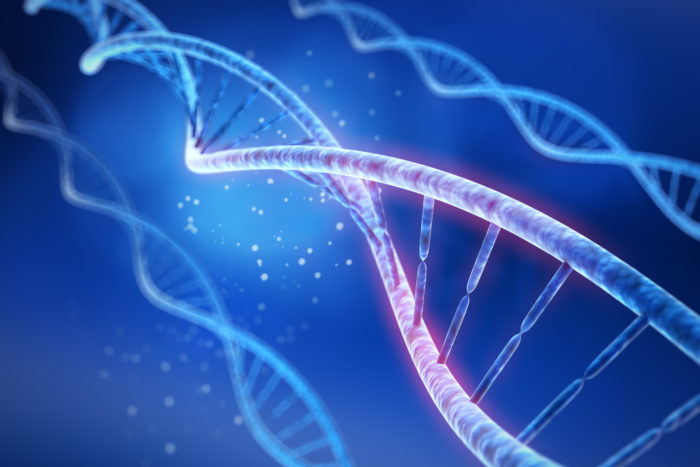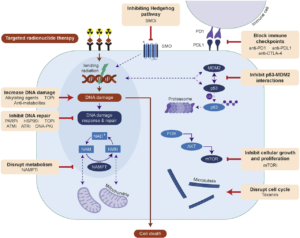

Radiotherapy is a treatment option for some prostate cancers.
Cells in your body normally grow and divide to form new cells. But cancer cells grow and divide faster than most normal cells. Radiotherapy works by hitting cancer cells with radiation which makes small breaks in the DNA inside them. These breaks keep the cancer cells from growing and dividing and cause them to die.
Normal, healthy cells in the tissue surrounding a tumor are also hit by radiation, but healthy cells are better able to repair themselves, and so can recover. However, some will still die along with the cancer cells. The death of healthy tissue causes side effects, and in some cases the damage caused by radiotherapy to surrounding tissue can be permanent.
In prostate cancer, the most common type of radiotherapy treatment is external beam radiotherapy, also called EBRT. EBRT is where beams of radiation are carefully aimed at the prostate tumor by a machine outside the body.


In the past few years, a promising new type of radiotherapy for cancer has emerged.
Targeted radionuclide therapy, or TRT, involves attaching antibodies or proteins to radioactive substances. These antibodies or proteins are chosen because they bind to proteins found specifically on the surface of cancer cells. This means that they can guide the radiotherapy directly to the cancer cells. Targeting cancer cells like this reduces the radiation dose healthy cells are exposed to and so lessens side effects.
TRT is possible in prostate cancer because of Prostate-specific membrane antigen (PSMA). PMSA is found on the surface of most prostate cancer cells but not on normal prostate cells. Lutetium-177 (177Lu) is a radioactive molecule that is attached to PMSA, forming 177Lu-PMSA. The PSMA guides the radiotherapy directly to cancer cells which take it up and die from DNA damage. Healthy cells are spared from the radiation. Because of this highly targeted approach 177Lu-PMSA could result in fewer side effects than standard EBRT.
This therapy is also systemic – it reaches your whole body through your blood. As the radioactive treatment is injected into the bloodstream the markers aren’t limited to your prostate. They can find prostate cancer cells expressing PMSA that have spread elsewhere within the body. This means TRT may also be an effective treatment for metastases.
177Lu-PMSA TRT is becoming more widely available across the UK and could help many patients. Although promising results have been found for this form of TRT, currently only 30% of patients benefit from treatment. To try and improve TRT outcomes scientists are currently testing two techniques:
177Lu-DOTATATE is another type of TRT that can be used in some prostate cancers. 177Lu-DOTATATE has been tested in many combination therapies – more than 177Lu-PMSA – and so is discussed a lot in this review. Whilst PCR are funding work on PMSA, the results found for 177Lu-DOTATATE are valuable as we might be able to use some of the lessons learned to improve 177Lu-PMSA.
This review discussed the TRT combination therapies tested so far and the next steps that need to be taken to translate this research into better treatments for prostate cancer patients.

Combination therapy is where more than one drug or therapy is given to treat a single disease. Many different drugs are being tried alongside TRT to see if by using both, researchers can increase TRT effectiveness. Some of the approaches being tried to make cancer cells more sensitive to radiation are:
Increasing our general understanding of TRT is essential if we want to improve its outcomes. We could then predict which drugs might be more effective in combination with TRT, saving precious time for patients and their families.

One way to increase the effectiveness of TRT is to combine it with other therapies which also cause DNA damage in cancer cells.
Clinical trials are currently underway testing chemotherapy and TRT combination therapy in other cancers.
Preventing cancer cells from repairing DNA damage makes cancer cells more susceptible to TRT. Several clinical trials assessing the safety and effectiveness of this combination therapy are underway. Many of the trials involve PARP inhibitors, and these drugs have shown promising results so far. PARP proteins are involved in the repair of DNA and are activated when a cell detects a break in the DNA. As TRT works by creating such breaks, stopping PARP proteins from fixing them could make cancer cells more susceptible to TRT.
Multiple studies testing EBRT and drugs that block a protein called mTOR have shown positive effects.
mTOR controls cell growth and division, but in cancers it often acts unusually, leading to increased tumor growth. Despite the encouraging results with EBRT, when the same drugs have been used with 177Lu-DOTATATE TRT, different studies have produced results that contradict each other. Some report positive effects, some negative effects and others studies suggest no difference to using the treatments on their own. more work is needed to determine whether this is true.
Taxane drugs bind to parts of a cell’s skeleton. This prevents the cell from being able to divide, leading to cell death. Taxanes also halt the cell at a point where it is particularly sensitive to radiation. They have been used successfully in combination with EBRT and there are promising early results for use with TRT too. When taxanes and TRT are given to a patient, and in what order, likely has a particularly important role in their effectiveness.
Many drugs that work by different methods are also being trialed.
Many other drugs are being investigated in combination with TRT to see if more patients can benefit from this treatment, such as inhibiting hedgehog signaling (a communication pathway that promotes cancer growth), or controlling the tumor suppressor protein p53 Another strategies under investigation is to disrupt normal cell processes that must take place for a cancer cell to survive by inhibiting a protein called NAMPT. And lastly, cancer cells can evade our immune systems by displaying certain proteins on their surfaces. Drugs have been created which block these proteins so our immune systems recognize the cells as cancerous and kill them.
Tiffany and Bart’s article highlights how important timing is for combination therapies. Often, combining therapies only improves the treatment outcome when they are applied at specific times and this varies between different drugs. Therefore, research into whether each drug should be given before or after radiotherapy, or simultaneously, is essential.

Combining TRT with other drugs gives better patient results than using either radiotherapy or the drug alone.
However, this is not the only benefit. Combination therapies may also mean lower doses of drugs and fewer treatment cycles may be required. This would help reduce the side effects prostate cancer patients experience, providing people with a better quality of life. Side effects not lifelong. Several drugs have shown promising early results and are now in clinical trials, with many more lined up for the future. Growing numbers of triple-combination therapies are also being tried out. Treatment outcomes are weighed up against any extra side-effects or impacts on patient quality of life.
Importantly, the review makes clear that more work into understanding exactly how TRT works, and how it interacts with the drugs it is being applied with. This is essential for effective and safe TRT combination therapies. It will also help us to stratify patients and tailor their treatment precisely to their cancer, helping more men survive prostate cancer, and with fewer side effects.
Scientific publications, commonly referred to as papers, are how scientists share their own work or review the work done by others. In order to be accepted for publication in a journal, they must first be approved by experts in the field (“peer-reviewed”). As such, they are a testament to a scientific team’s credibility and the quality and reliability of their work. Both the stamp of approval given by a publication and the ability for other scientists to learn about and build upon a team’s research are important steps to take lab science closer to real-life benefits for humans.
This publication is a review article, in which a team of scientists explore and give an overview of the current knowledge on a particular subject. Review articles may also highlight areas for future research or draw new conclusions from existing research. Review articles are a good way for a team of scientists to help other scientists work more quickly by compiling and sharing important areas of expertise. When scientists are planning future studies, review articles can also help them to decide on the most appropriate methods to use for their research.
This paper, under the full title “Combination Strategies to Improve Targeted Radionuclide Therapy” was published in The Journal of Nuclear Medicine. The publication is open access, meaning the information is available to readers at no cost, and the journal’s Impact Factor (a measure of a journal’s influence in academic research circles) is 7.9. The top 4% of journals have an Impact Factor above 7.
The researchers who contributed to this paper are Bart Cornelissen, Tiffany Chan, Edward O’Neill and Christine Habjan. They are based in the Department of Oncology at the University of Oxford.